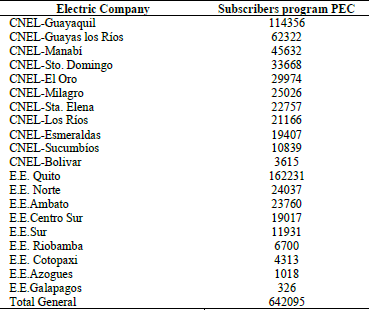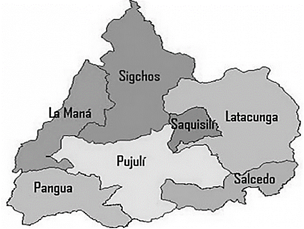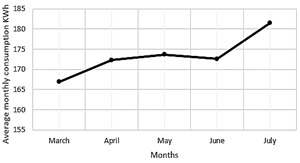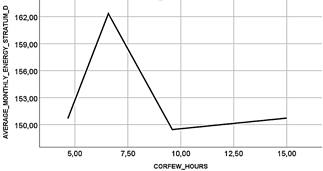1. Introduction
According to [1] the 2013-2022 electrification master plan proposed by the CONELEC, the demand at the limits of the analysis 2013-2022. The relevant energetic politics expects a massive addition of 3.5 million of electric induction stoves starting in year 2015 up to 2017 with a penetration of 80% in residential users and a gradual penetration up to 90% in year 2022.
A study [2] applied in the Chimborazo province mentions that the average consumption of every subscriber to the PEC (Energy Efficiency Program for induction cooking and electric water heating) was 29.44 kWh for the usage of the induction stove, this data projected to the whole quantity of residential subscribers registered until December 2016 (147.287 subscriptions) shows that the EERSA requires 52’033.548 kWh annually.
According to the actual conditions it is necessary to know the relation between the curfew measures dictated by the national COE (Emergency Operation Center) and the electric energy consumption by household subscribed to the PEC.
Therefore, it is proposed to analyze if the energy consumption of the PEC’s subscribers is related to the curfew measures in the Cotopaxi Province during COVID-19 times.
The analysis is based on the energy consumption data of the residential users of the PEC, the data was extracted from the “Empresa Eléctrica Cotopaxi S.A.” (Cotopaxi Electric Company) databases, after applying a linear regression an estimated consumption by the users of the residential subscriptions to PEC was obtained, for before and after the WHO declared the COVID-19 as a global pandemic and the national COE dictated the curfew measures and the lockdown.
Finally, it is considered that the estimated variance in the electric energy demand in COVID-19 times will allow to obtain the approximated real domiciliary energy consumption, and this will serve as a tool to Elepco S.A. to plan actions and provide an uninterrupted quality service.
2. Literature revision
2.1 Energy Efficiency Program for induction cooking and electric water heating (PEC)
The residential fare for PEC Program “Emblematic Efficiency Program for induction cooking and electric water heating to replace LPG in the residential sector”, was introduced in the tariff schedule after the CONELEC resolution No. 058/14 on July 15 of 2014 and was billed since August 1 of 2014. [3]
Later on, the ARCONEL directory approved during a meeting on December 2 of 2015, the ARCONEL Regulation No 005/15 “Model of bill for the payment of electric basic services and general public lighting”, which includes as part of the billing concept, the application of the fare incentive and the induction stove financing for those user willing to accept those incentives. [3]
In Table 1 it is shown the number of PEC’s subscribers regarding the distribution company.
Table 1 Subscribers of program PEC december 2018.

Source: A. de regulación y control de Electricidad, 2018
According to [3] on December of 2018 there was a total of 642095 subscribers of the PEC program. The Cotopaxi Electric Company registered 4313 subscribers, this represents the 0.67% of the national users, recording on 2018 a total of 6.59 GWh, the government subsidies 1.66 GWh. Which represents a billed value of 680000 USD and a subsidy of 150000 USD, all this from users subscribed to the PEC.
2.2 ELEPCO S.A. concesion area
According to its foundation documents, ELEPCO S.A. has as a fundamental objective to provide electric services to the designated concession area the Cotopaxi Province as you can see in Fig. 1. Following the Legal Regime Law for the Electric Sector, its reforms, regulation, statements and other current laws of the republic. [4]
The concession area of the “Empresa Eléctrica Cotpaxi S.A.” covers the cantons: Latacunga, Salcedo, Saquisilí, Pijulí, La Maná, Pangua and Sigchos those which conform the Cotopaxi Province. [4]
2.3 Induction stove
Briefly, as can be seen in Fig. 2 an electromagnetic induction stove is and electric magnet. There is a coil under the surface of the stove with an electronic control, when the unit is started, an electric flow runs through the coil creating an magnetic field which can be controlled and used to heat and cook the meals without any inconvenience. [4]
2.4 Responsive measures dictated by the National COE due to COVID-19 health emergency.
On 03-11-2020 the WHO declared the COVID-19 as a pandemic, following this, through the Ministerial Mandate Letter No 00126-2020 issued in the same date by the Health Minister, a Public Health Emergency is declared nationwide.
The national government designed a strategy to prevent a community spread in the country which represents the main risk. These measures have as their purpose to incentivize the consciousness and responsibility in the citizens, in order to prevent a wider and faster spread of the virus and contain its impact. [5]
Between all the mobility restrictive measures that the National COE dictated involving the Cotopaxi province, for this study there are four main measures in the month of March: The cancelation of academic activities, remote jobs and an average of 4.67 hours of curfew on this month, 15 hours for April and May, for June an average of 9.6 hours of curfew and 6.58 for July, no presential academic activities and remote labor are emphasizes until the month of July.
3. Electric energy consumption on the Cotopaxi province during COVID-19 times
The Cotopaxi province is composed by 7 cantons, with a total of almost 300.000 inhabitants from where 100 thousand reside in urban areas and 200 thousand in rural areas. It is located on the North Center region of the “Callejón Interandino” Interandean Alley of the Republic of Ecuador [6].
As can be seen in Fig. 3, there is a faster increase of electric energy consumption in the province from the year 2011 to 2013.

Source: A. de regulación y control de Electricidad, 2018
Figure 3 Historical energy consumption of the province of Cotopaxi.
The behavior of consumption of electrical energy before and after the pandemic of PEC subscribers is described next.
3.1 Electric Energy Consumption for PEC subscribers before COVID-19
Fig. 4 shows the electric energy consumption tendency for the PEC program users in Cotopaxi for the years 2018 and 2019. After analyzing this data and average monthly consumption was calculated for every user, 167.55 KWh for 2018 and 165.98 KWh for 2019.
In Table 2 the consumption is divided in four strata A, B, C, D to categorize the users by their consumption average.
3.2 Electric Energy Consumption for PEC subscribers after COVID-19
Fig. 5 details the consumption tendency from the month of March to July of 2020 for the PEC program users. After analyzing this data, the average consumption per user is 173.36 KWh.
In table number 3 the four strata A, B, C, D to categorize the users according to their consumption is shown.
4. Metodology
To analyze the variance in the consumption of electric energy of different users of the PEC program, data was collected from ELEPCO S.A. and tabulated.
Then four strata A, B, C, D were taken into consideration in order to categorize the users according to their energy consumption, to differentiate the users by the usage the strata A and B are formed by urban user, meanwhile the strata C and D are formed by rural users. For stratum “A” a monthly consumption of 300 KWh or higher was established, stratum “B” a consumption between 200 and 299 KWh, stratum “C” a consumption between 101 KWh and 199 KWh, stratum “D” a consumption of 100 KWh or below.
With the average hours of curfew by month, the mathematical model of lineal regression is applied which gives us the relation between the studied variables, independent variable (curfew hours) and dependent variable (monthly consumption in KWh of PEC users). In order to predict the behavior and tendencies of these variables, based on real consumption data in the period from March to July of 2020. Using the characteristic equation found in this study, the electric consumption average for the month of August was predicted.
5. Results and analysis
The first obtained result based on the analysis of the consumption curves of figure 6. Is that the same growing behavior can be seen in the months of March and April but during COVID-19 times, the same tendency is maintained through the month of July.

Source: The author.
Figure 6 Consumption trend comparison 2018 2019 and 2020 in COVID-19 PEC subscribers.
The increase rate for each stratum is shown in table 4, in the period between the months of March and July of 2020 every stratum presents an increment in the consumption, for example the stratum B shows a maximum value of 8.02% this stratum correspond to urban sectors, but a singular value of -0.31% in the stratum D which represent a decrement in the consumption contrasting with the same period of 2019.
Table 4 Electricity consumption increase rate march-jul 2019 and 2020 in COVID-19 of PEC subscribers by strata.

Source: The author
In Fig. 7-10 the relation between the curfew hours and the average monthly consumption of the PEC subscribers can be seen. The results that the graphics show the real relation between the mentioned variables in the strata A and B with a significance of 0.139 and 0.08 respectively after applying the lineal regression, however in the strata C and D does not exist any relation between the curfew hours and a none existing consumption increment.
Based on the linear regression the monthly consumption for the month of August has been projected, in which the National COE dictated the curfew schedule from 21:00 to 05:00, giving as a result and estimated monthly consumption of 215.441KWh for stratum A and 191.383 KWh for stratum B per user.
6. Conclusions
It has been proved that there is a relation between the curfew schedule mandated by the national COE and the electric energy consumption per subscriber of the PEC program in the strata A and B, however in the strata C and D with a significance of 0.64 and 0.65 respectively concludes that there is no relation between the curfew hours and the increment of consumption. Which means that there are other factors that intervene in the behavior of these strata.
As a conclusion as can be seen in table 5 there is a 4.24% increment in energy consumption between the months of March and July of 2019 and the same period of 2020, and as can be seen in table 6 regarding the curfew schedule dictated by the COE and a 5.17% increment between April and May if 2020 in which the national COE dictated 15 hours of curfew in the Cotopaxi Province. Meanwhile in the stratum B an 8.02% increment is registered as consequence of COVID-19 response measures in the PEC users in the Cotopaxi province.
Table 5 Consumption increase rate march-july 2019 versus 2020 in COVID-19 of PEC subscribers.

Source: El author
Table 6 Consumption increase rate april-may 2019 versus 2020 in COVID-19 of PEC subscribers.

Source: The author
For future research it is suggested to analyze the behavior of stratum D. that presents an decrease rate of -0.31%, this value of reduction in energy consumption may be related to factors such as that curfew hours in rural sectors do not follow the entire rules it is possible that there is not a rigorous control by the authorities in these areas, this would explain that the electric energy consumption and the curfew schedule mandated by the national COE is not related in the strata C and D, it is recommended for future research to deepen and involve more variables that could affect the consumption behavior of users corresponding to stratum C and D for the PEC subscribers in the Cotopaxi province.
It is suggested to carry out an analysis in the other provinces to obtain data in the most populated areas of the country and to go up to a study at the national level that will be very useful for the national COE to consider the incidence in home electricity consumption in restrictive measures of curfew.
























